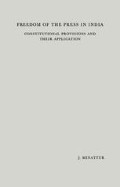Abstract
Before we proceed to examine the constitutional provisions relating to freedom of the press in India, it is necessary to investigate what is meant by the expression “freedom of the press” in this context.
Access this chapter
Tax calculation will be finalised at checkout
Purchases are for personal use only
Preview
Unable to display preview. Download preview PDF.
Reference
Ramesh Thappar v. State of Madras, 1950 S.C.R. 594 at 597
Brij Bhusman v. State of Delhi, 1950 S.C.R. 605 at 608
Srinivas Bhat v. State of Madras, A.I.R. (1951) Madras 70 at 73
In Express Newspapers v. Union of India, the Supreme Court of India said: “It is trite to observe that the fundamental right to the freedom of speech and expression enshrined in Article 19(I) (a) of our Constitution is based on these provisions in Amendment I of the Constitution of the United States of America and it would be therefore legitimate and proper to refer to these decisions of the Supreme Court of the United States of America in order to appreciate the true nature, scope and extent of this right in spite of the warning administered by this Court against the use of American and other cases.” (1958 S.C.J. 1113 at 1157-58)
Note also the observation: “Our Constitution has drawn freely inter alia upon the Constitution of the United States” (Bhagwati, J., in Bengal Immumity Company v. State of Bihar, 1955 S.C. J. 672 at 714).
Schneider v. Irvington, (1939) 308 U.S. 147 at 160 8 id. at 161
Thomas v. Collins (1945) 323 U.S. 516 at 544
Associated Press v. United States, (1945) 326 U.S. I
Associated Press v. National Labour Relations Board, (1936) 301 U.S. 103 at 140. 19 Lovell v. Griffin (1938) 303 U.S. 444 at 451
Re Jackson, (1878) 96 U.S. 727
Associated Press v. National Labour Relations Board, (1936) 301 U.S. 103 is ibid.
1935) 297 U.S. 233 at 250. The case was concerned, among other things, with the question whether the First Amendment provided protection against a licence tax levied for “selling, or making any charge for, advertising.“ Sutherland, J., in his opinion, related how in England in the 18th century the imposition of taxes had been used for the purpose of gagging the press, and expressed the view that such "modes of restraint” as the one involved in the case were inhibited by the constitutional provision.
1936) 301 U.S. 103
Express Newspapers v. Union of India, 1958 S.C.J. 1113 at 1161
This was pointed out by the Commission on the Freedom of the Press in the United States. (A Free and Responsible Press, p. 81)
D. C. Holland, Freedom of the Press in the Commonwealth, Current Legal Problems, Vol. IX (1956) p. 186.
While emphasising the point that freedom of the press is not a freedom from responsibility for its exercise, it has been said in the United States: “That there was such a legal liability was so taken for granted by the framers of the First Amendment that it was not spelled out.” (Frankfurter, J., in Pennekamp v. State of Florida, (1946) 328 U.S. 331
The interests of the community seem to have been given legitimate emphasis in the Dutch Staatsregeling of 1798. Article 16 of the Staatsregeling begins with the declaration that “Every citizen may utter and spread his sentiments in whatever way he sees fit, which is not inconsistent with the purpose of the community.” (emphasis added)
Hamdard Dawakhana v. Union of India, 1960 S.C.J. 611
Valentine v. Chrestenson, (1942) 316 U.S. 52
Hamdard Dawakhana v. Union of India, 1960 S.C.J. 611 at 621
Author information
Authors and Affiliations
Rights and permissions
Copyright information
© 1961 Springer Science + Business Media B.V.
About this chapter
Cite this chapter
Minattur, J. (1961). Introduction. In: Freedom of the Press in India. Springer, Dordrecht. https://doi.org/10.1007/978-94-011-9103-6_1
Download citation
DOI: https://doi.org/10.1007/978-94-011-9103-6_1
Publisher Name: Springer, Dordrecht
Print ISBN: 978-94-011-8398-7
Online ISBN: 978-94-011-9103-6
eBook Packages: Springer Book Archive

